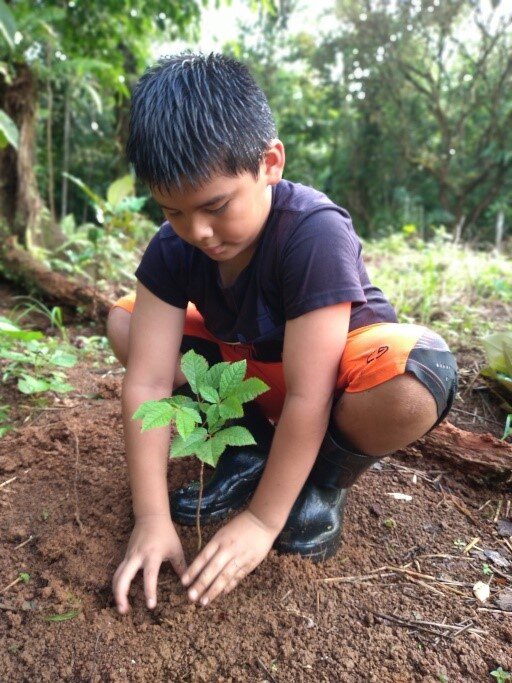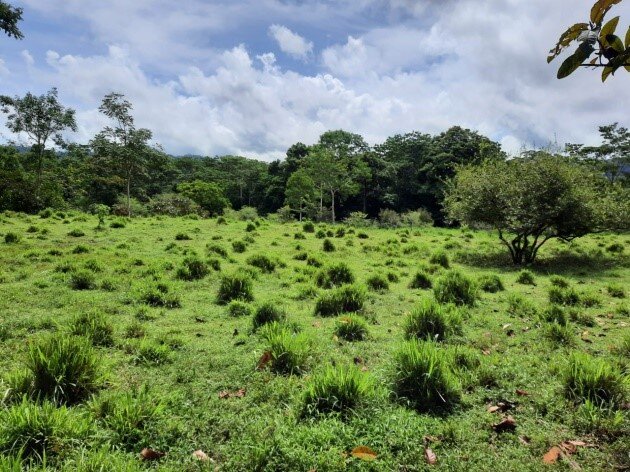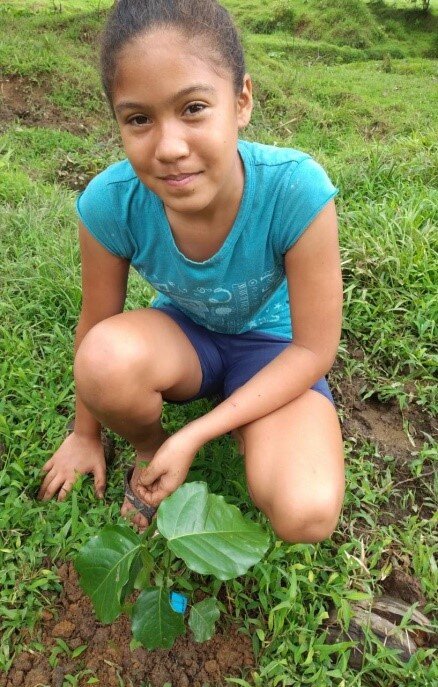local livelihoods & primate HABITAT RESTORATION
As part of our restoration work for the next decade, we will work together with our local partner, the Corcovado Foundation, situated in the tropical and biodiverse Drake Bay hotspot of Costa Rica. Here we will all work together to promote and help local landowners with creating new sustainable livelihoods through Analog forestry, while also planting trees to restore forests for endangered wildlife. Restoration efforts without the involvement of local communities will never be sustainable. With your support, we will be able to offer local people in this ecological place of wonder a socio-economic opportunity to live from nature, while work in tune with it instead of against it, and ultimately help restore local natural areas and its wildlife populations.
Drake Bay, costa rica
Located in the southern part of Costa Rica, the Osa Peninsula is one of the most biodiverse regions on the planet with up to 3% of its flora found nowhere else in the world. You will find Bahía Drake, or Drake Bay, on the North side of the peninsula which until recent years was only accessible by boat. It remains a remote area of the Osa Peninsula, which is somewhat difficult to reach, yet will offer any visitor many natural wonders and stunning, raw natural beauty with its tropical forests, sandy beaches and diverse wildlife. It is in this area that we will support and work with local families on Analog Forestry, restore local habitats and food sources for wildlife like the Spider Monkey, and contribute to educational activities with local children in the area.
analog forestry - creating local livelihoods
Why do we need a new approach to creating livelihoods for people in Drake Bay? The economic pressures on this region, as well as the limited access to education and job opportunities, have led many residents to view the trees from an instrumentalist perspective. This has had, and continues to have, a significant impact on the ecosystem of the region. The main threats to the forest result from the complicated economic situation of the region and the lack of continuous and quality environmental education.
It is therefore essential that restoration efforts also provide locals an opportunity to create a livelihood that works in tandem with the forest restoration efforts, making people, wildlife and wild areas become interdependent on each other. Drake Bay consists of many smaller rural towns whose populations rely on their own development in very hard conditions, due to its isolated location and situation. Traditionally the economic activity in the area depended mainly on farming and livestock. It was a very subsistence economy, where hunting wildlife and logging were common practices. These kinds of activities have generated fragmentation in the area and a loss of biodiversity, affecting endangered species like jaguars, monkeys, macaws, tapirs and more.
“For the past years, tourism is the principal economic activity and the majority of the population in Drake Bay depends directly or indirectly on this industry. After the pandemic hit, unemployment has increased dramatically in the area and resulted in more damaging practices to the forest and our wildlife to make a living again. This is why creating awareness of the forest ecosystem services and work in forest restoration is more important than ever to protect Osa Peninsula forests and its biodiversity. All while we help local families have a better food source without damaging chemicals, make a living and reduce their impact on the ecosystems surrounding them.”
- Alejandra, Director of Corcovado Foundation
what is analog forestry?
Analog Forestry is a holistic approach to silviculture by using natural forests as guides to create socio-economic productive landscapes. Not to be confused with Agroforestry, it is a concept of having crops that locals can harvest to their socio-economic benefit, which are natural to local ecology and the environment, while gradually building and restoring the local forest in the process. This is often applied to degraded agricultural lands, and as the restoration of the local forest comes along, locals will adapt and develop their species of crops accordingly.
Have a look at this great video to learn more about what we are trying to support and make happen for local communities in Drake Bay!
The crops, plants and trees to plant will be varied and decided upon based on the local area. For the forest restoration work, different tree species that are selected based on certain criteria will be planted. This includes how the species can be useful for fast soil recovery, its endangered status and its importance to feeding wildlife. This will include some of the following species that have been overexploited for its wood like Copaifera Camibar and Courati Guianensis (Copo hediendo) - important species for feeding wildlife like parrots, macaws, and rodent species; Astronium graveolens (ron ron) - a rare species in Osa Peninsula forests; Brosimum utile (Baco), and the Minquartia guianensis (Manú) which is in danger of extinction, but important for feeding different animal species like monkeys and birds.
the Perez family land in drake bay
The location of where the trees will be planted. The fragmentation of the forest areas are clearly visible as larger areas are cleared for agriculture and cut down for timber.
In the Los Ángeles de Drake community, you will find the Perez family’s 4.2 hectares property. It mainly consists of pasture for cattle with some patches of trees by the riverside and a water source within too.
The landowner wants to establish two reforestation areas. One area around the riversides to be reforested with trees that are important to feed wild animals. The other area is around the water source, where the priority would be to reforest with fruit trees. The goal is to plant close to 800 trees in the two areas.
By planting trees that are suitable for both wildlife and local people to make an income, it will create longer lasting changes and encourage locals to keep the forest standing.
the many benefits of analog forestry
Analog Forestry presents numerous benefits for the local communities, their livelihood, the local environment and threatened wildlife species:
Combining farming with forest restoration will decrease forest fragmentation, which helps local wildlife and biodiversity.
Buying native trees in local tree nurseries will help the local economy in the area.
Planting endangered tree species will help to recover their local population, whose natural dispersion is more difficult because of the decrease of its population
Planting tree species which are important for feeding wildlife will help recover biodiversity. This in particular applies to certain threatened species like the Spider Monkey.
Implementing soil recovery techniques at local properties will help decrease risk of land and soil degradation.
Planting native plants benefits pollinators, which will help dispersion of the flora in the area.
environmental education
It is also about the next generation! The values that we develop of what is important starts from a very young age. In our restoration efforts, it is therefore just as important to educate and teach children and young people about the importance of the environment, as it is planting the trees.
The educational part of the project will work with different groups of children in the five local communities of Rancho Quemado, El Progreso, Los Ángeles, Drake and Los Planes. The activities will integrate forest restoration activities with the groups, organising ‘forest restoration days’ where the children will help planting trees and native plants in local properties. They will take part in practical tasks, learn, plant trees and spend the day in nature with each other.
“Teaching and implementing forest restoration activities with children of the communities will help to create awareness of the importance of the forest ecosystem services.”
- Helena, Educational Lead at Corcovado Foundation
The children will be the future guardians of the local environment in the Osa Peninsula of Costa Rica, and by teaching them from an early age about the importance of a preserved and health environment, the efforts will hopefully last for future generations.
restoring primate habitats
Drake Bay is like most other parts of the Osa Peninsula rich in wildlife. From the sea turtles on the beaches and the colourful Macaws flying above, to the monkey species jumping around the tree canopy, and the majestic humpback whales passing through the bay. Three primate species inhabit these parts of the peninsula, including the endangered Geoffroy’s Spider Monkey (Ateles geoffroyi) local to Central America. However, like other wildlife species that roam outside the Corcovado national park located further south from Drake Bay, they are struggling to stay in this area due to logging and agriculture. These are direct causes of the loss in habitat and food sources, resulting in a continuous population decrease.
We will therefore through the Analog Forestry project alongside the Corcovado Foundation, also work together with the Saimiri Foundation on this issue, to restore their habitat through planting trees specific for the three current monkey species living in and around Drake Bay. This will be besides the other wildlife species that will also benefit from the planting of particular tree species to restore their habitat and sources of food.
how can you help forest restoration in costa rica?
We already have things in place and people locally in motion to make this work happen. We therefore welcome every donation to help make this take off and become continuous for people and wildlife in Drake Bay! Any donation regardless of amount will be much appreciated.
A donation on £10 will provide 1 tree planted for forest restoration in Drake Bay. So how will this be used? Each donation will:
Support the people of the local tree nursery that supplies the trees for the Analog Forestry project led by local women.
Provide direct funding to the local farmers that are on the journey to transform their livelihoods in a sustainable direction
Help local and endemic wildlife with the restoration and future preservation of their habitat and food sources by planting trees
Support the local people behind the project, who continues to promote the new ways of Analog Forestry with locals, assists with the planting of trees, and engage children in educational activities to teach the next generation about the importance of this work
We will only keep a small amount, so we can keep assisting our local partners with promoting their work, raise money for them and cover any admin/transaction costs.
To make a donation just click on the link or the right-hand ‘Donate Here’ button. Select how you would like to donate, the amount, fill in the details and choose the “Forest Restoration Project in Costa Rica” option.
If you prefer to donate via a bank transfer, then these are our bank details:
Account Name: Earth Restoration Service
Account Number: 20521957
Sort Code: 20-79-06
Just remember to write in the reference “Forest Project CR” so we know exactly which project these funds are directed towards.
Get in touch!
If you as an individual, business, organisation or foundation of any size would like to make any sized donations to help make this important restoration work happen, please don’t hesitate to let us know! We can also help provide some social media material that you can use to help promote the work, fundraise money or share that you have made a contribution!
Reach out to us on Charlotte@earthrestorationservice.org to hear more about how you can support and be part of these efforts.







